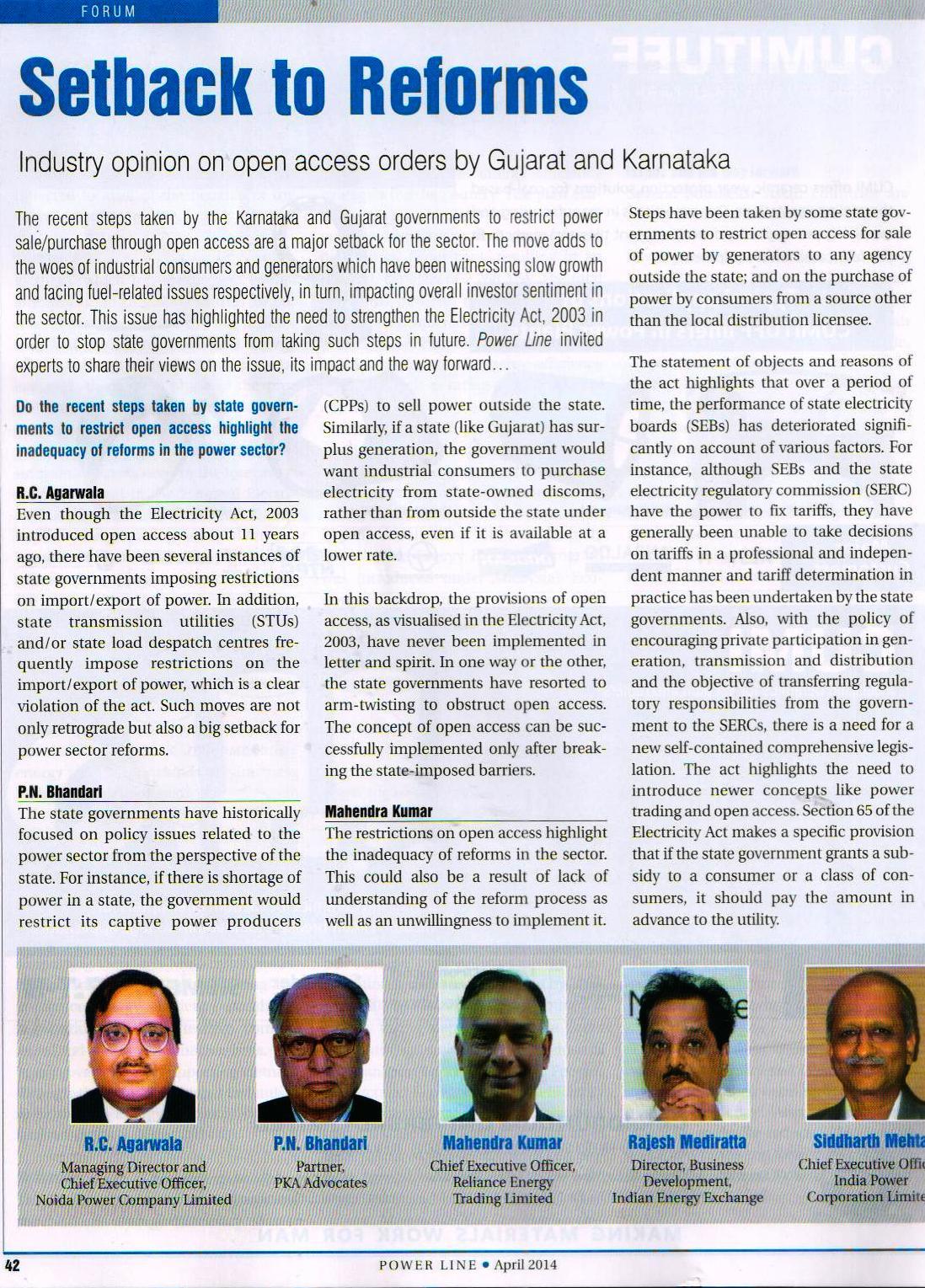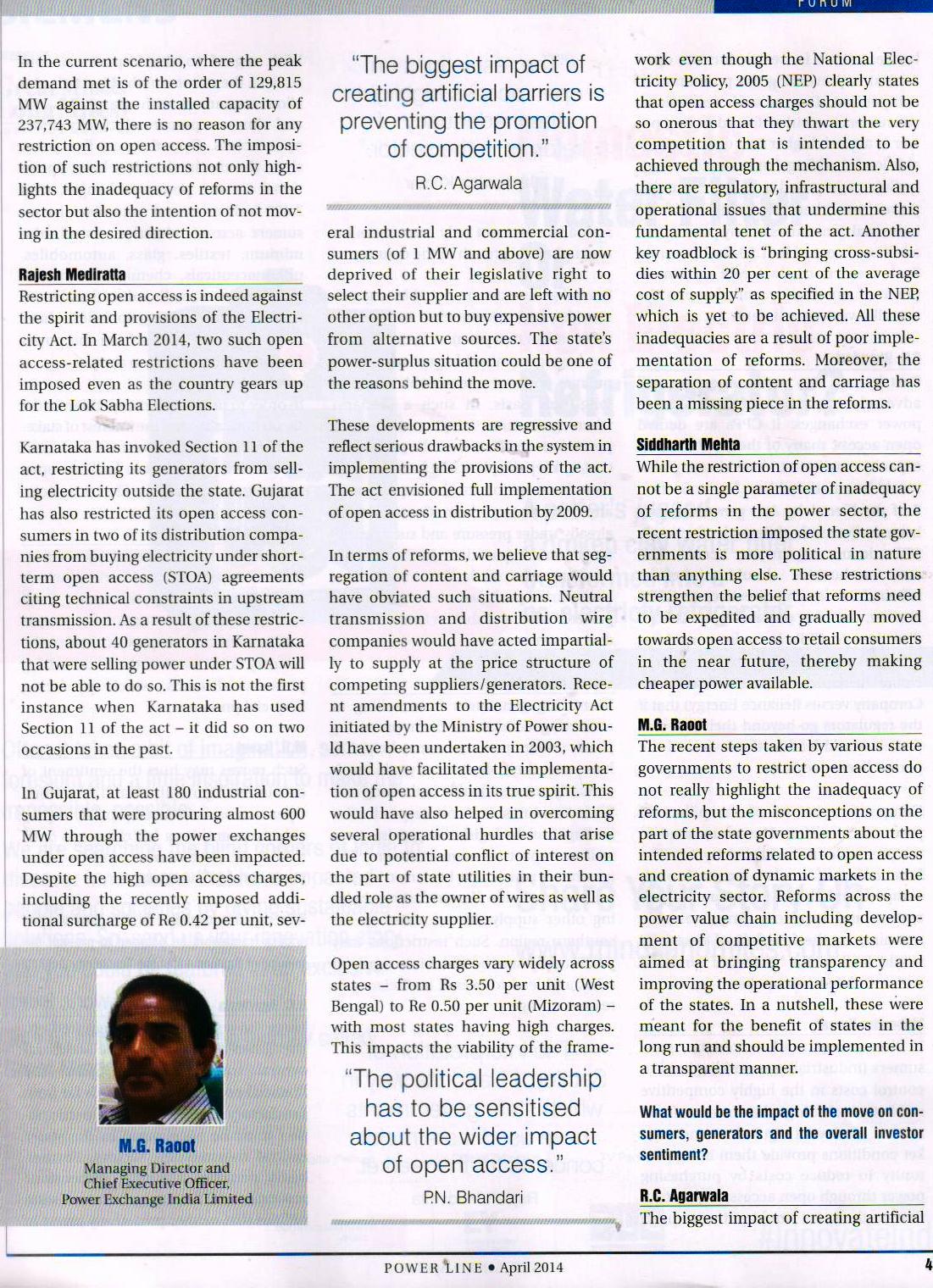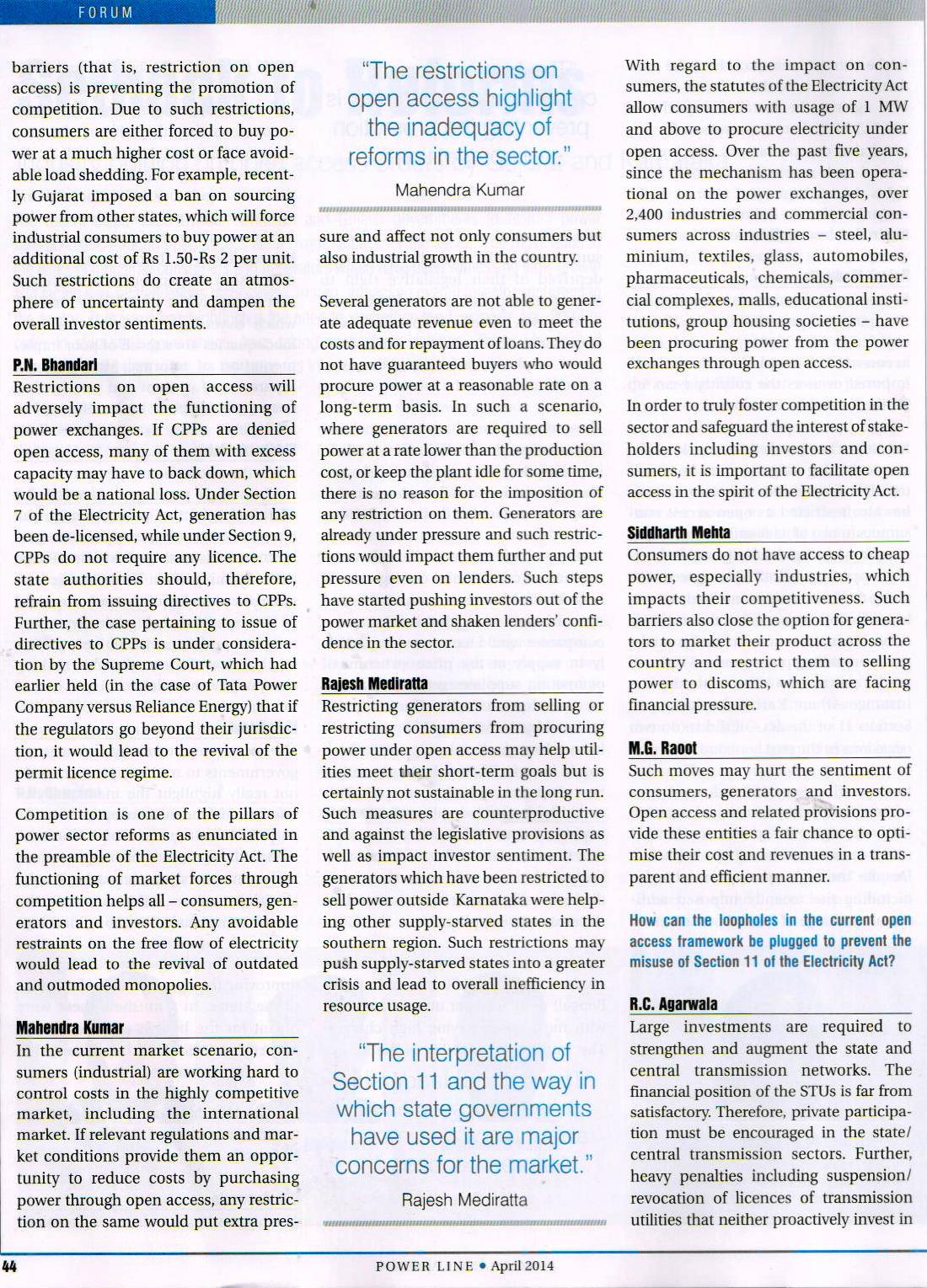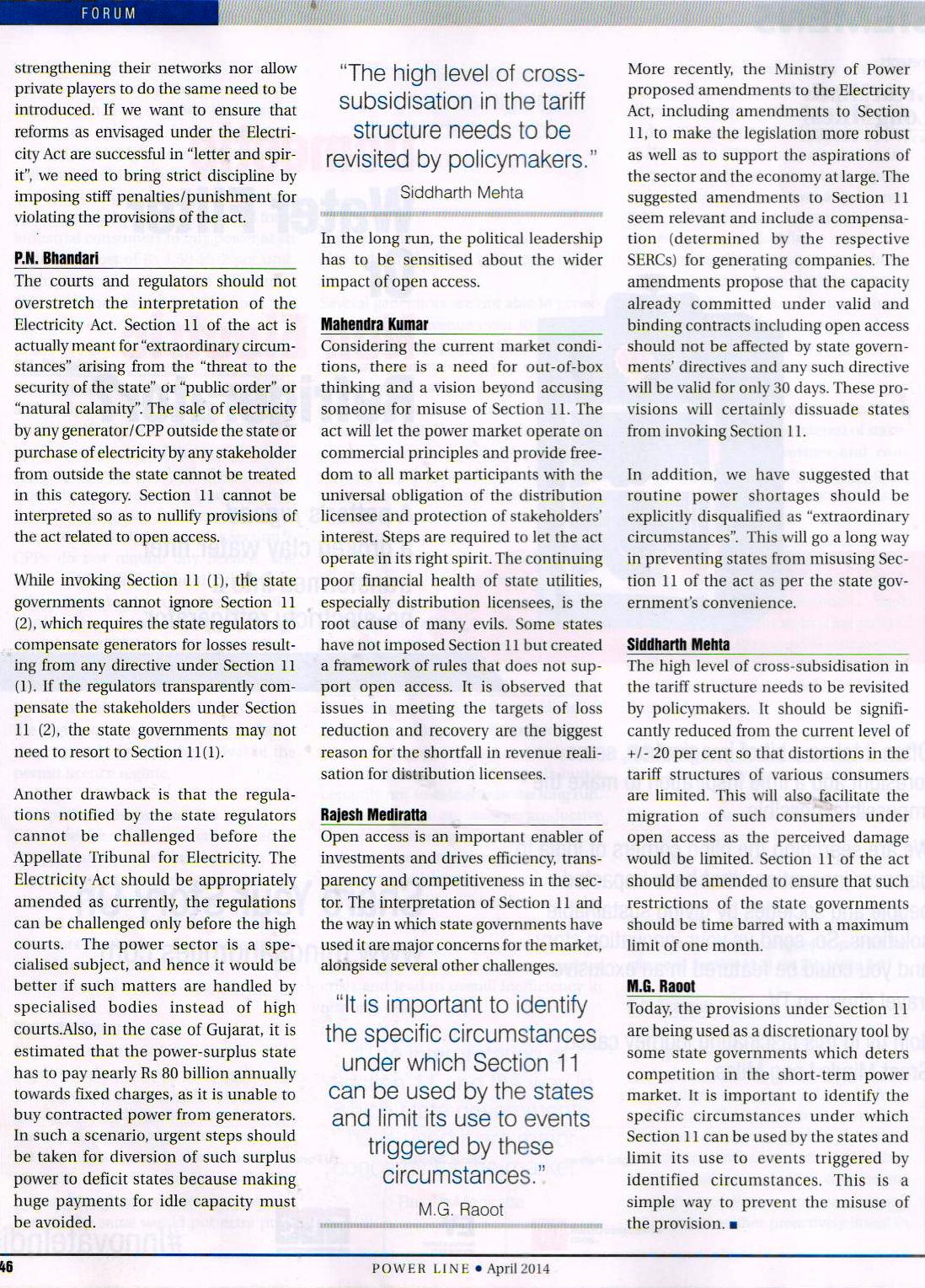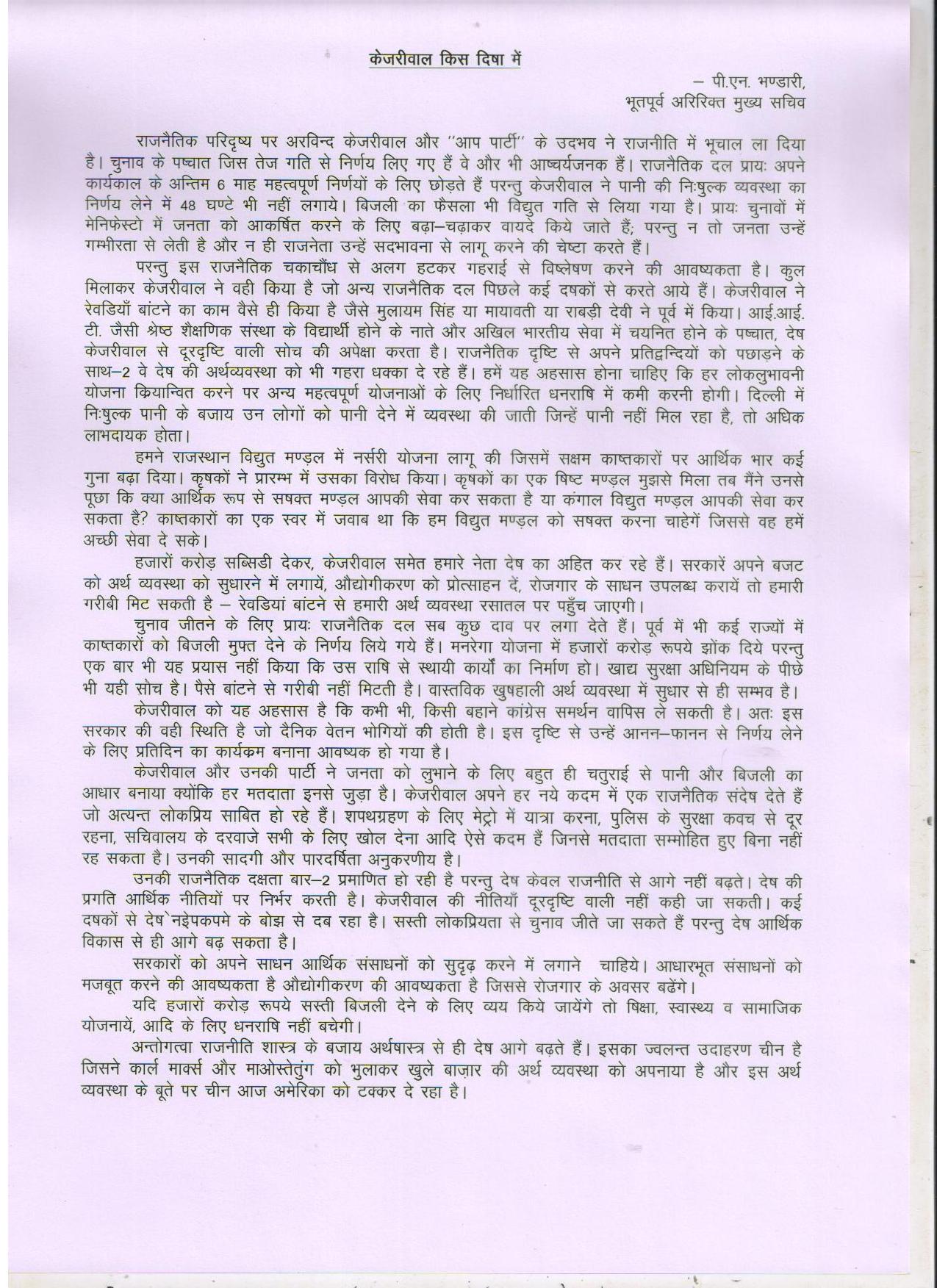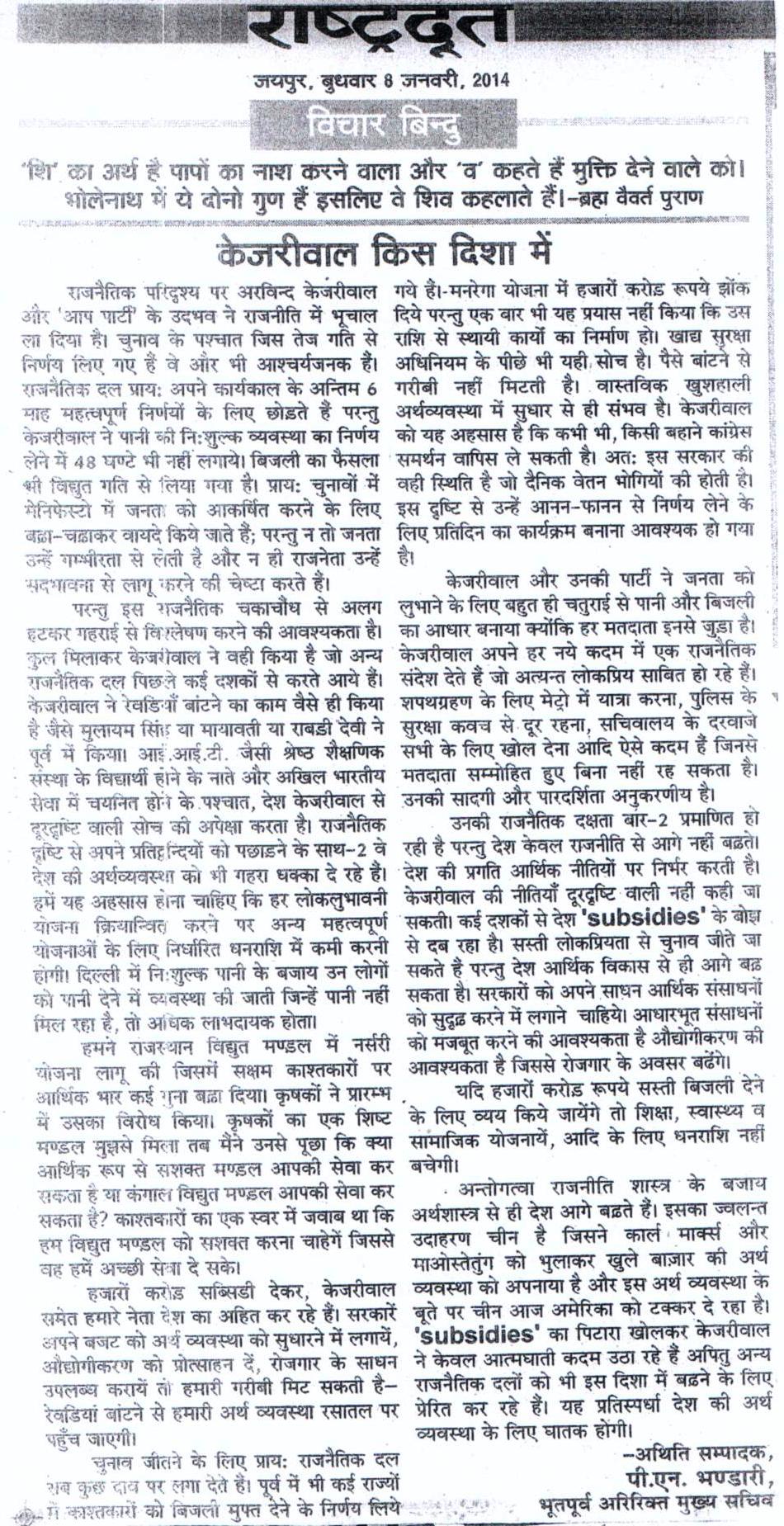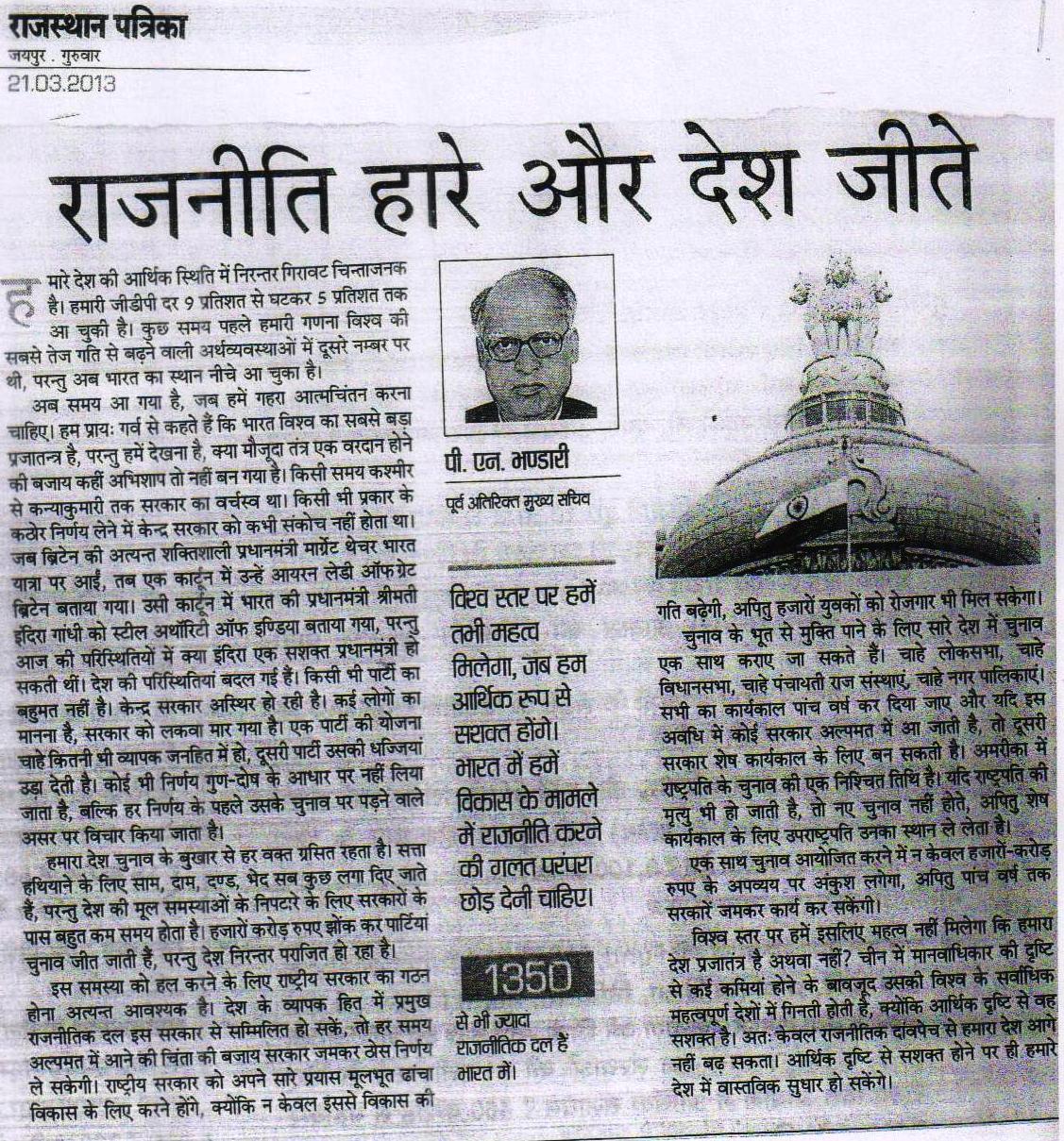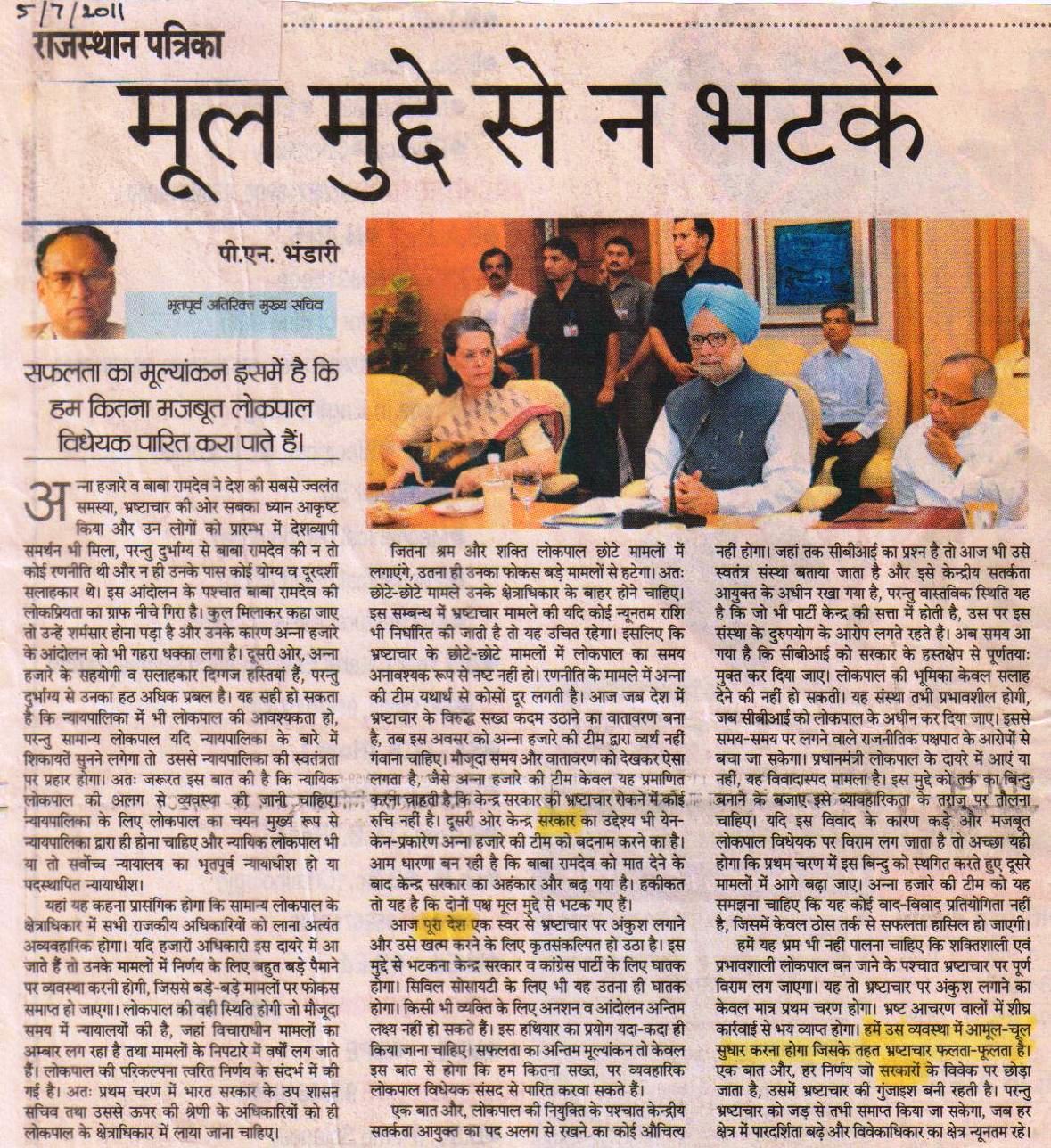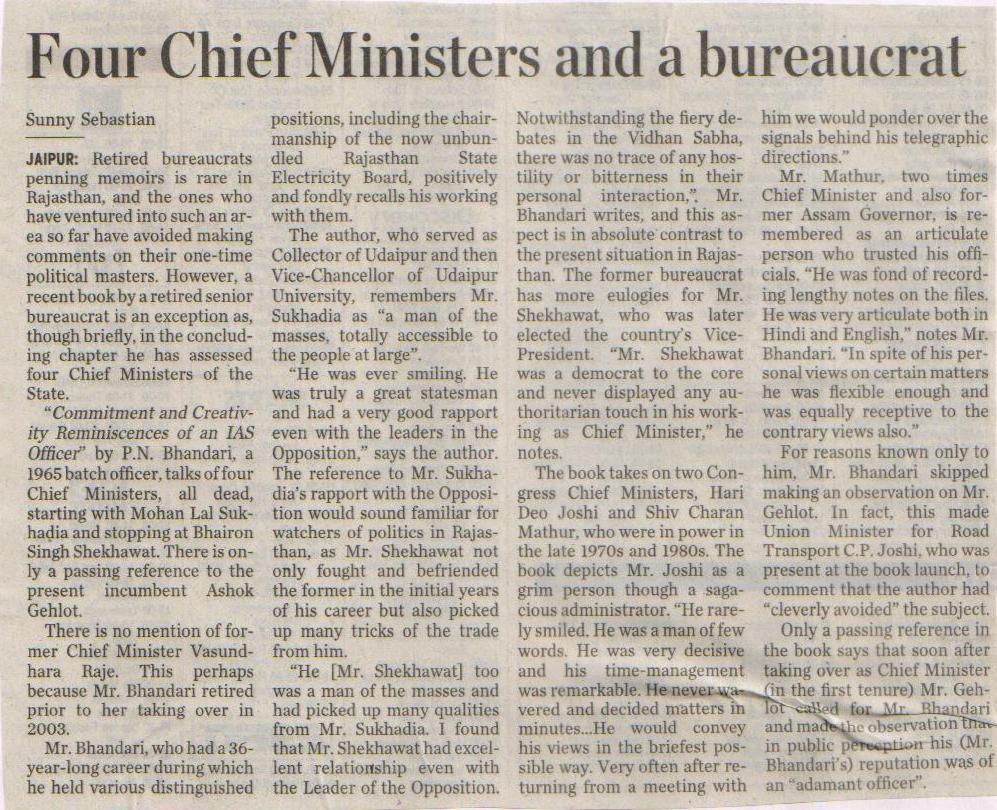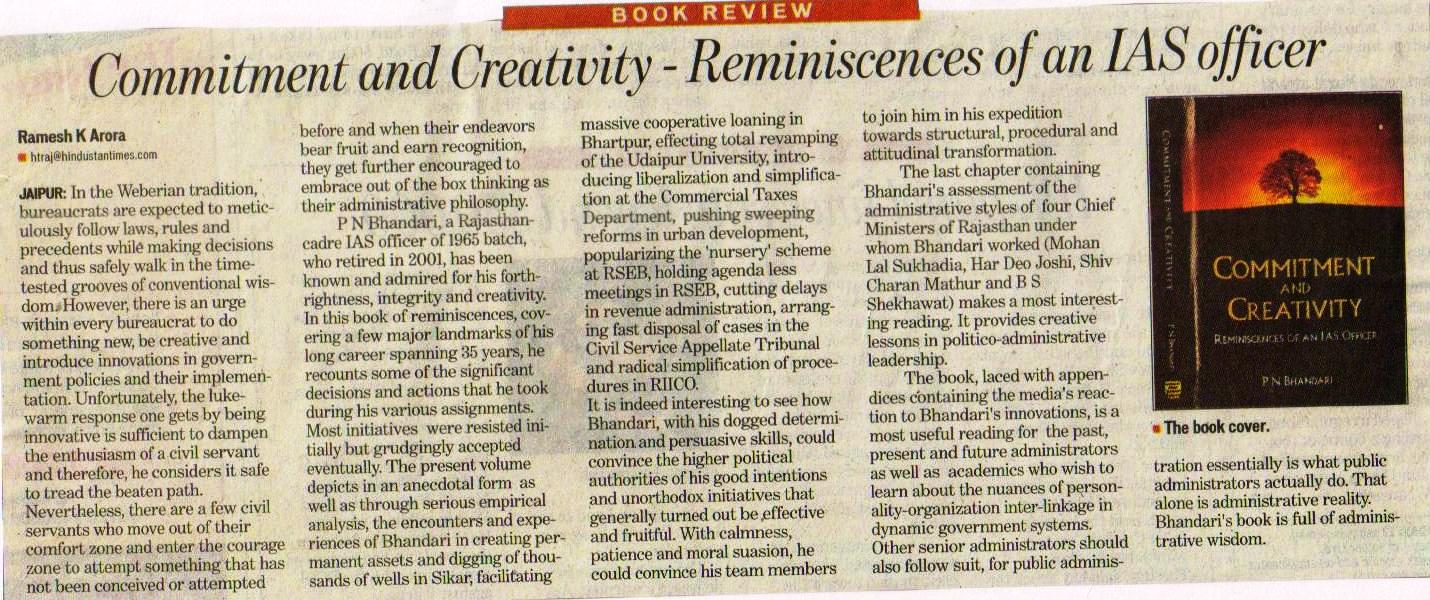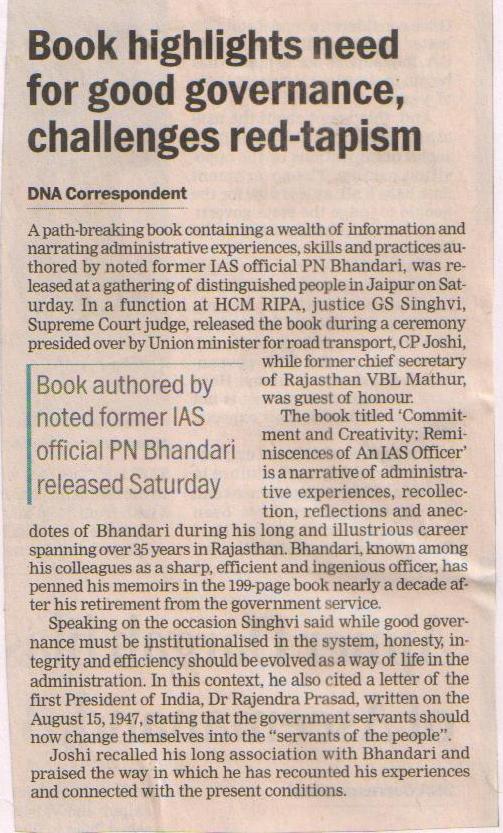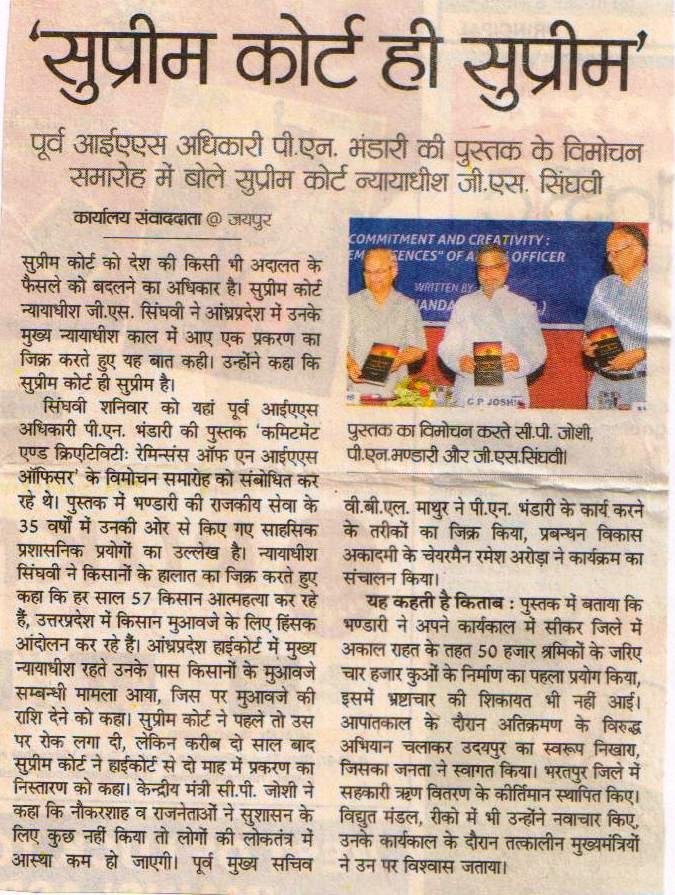
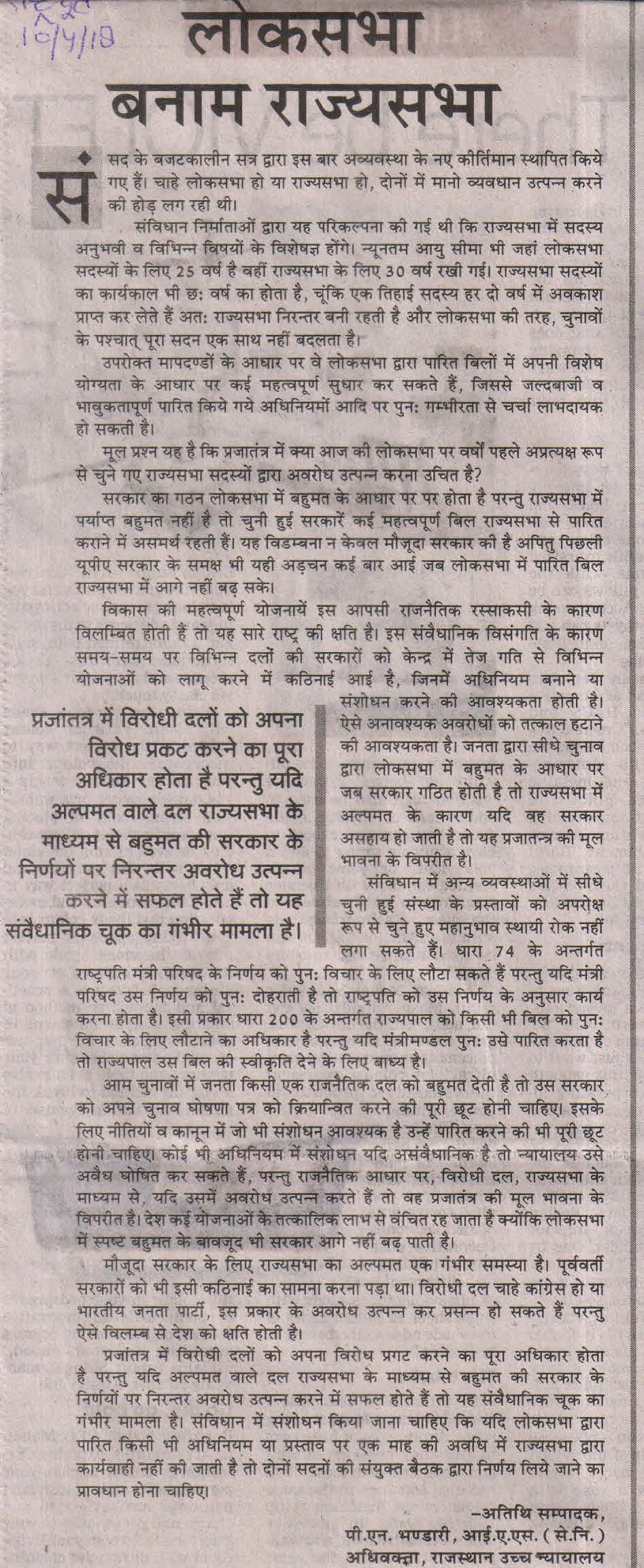
Rashtradoot, 10th April 2018
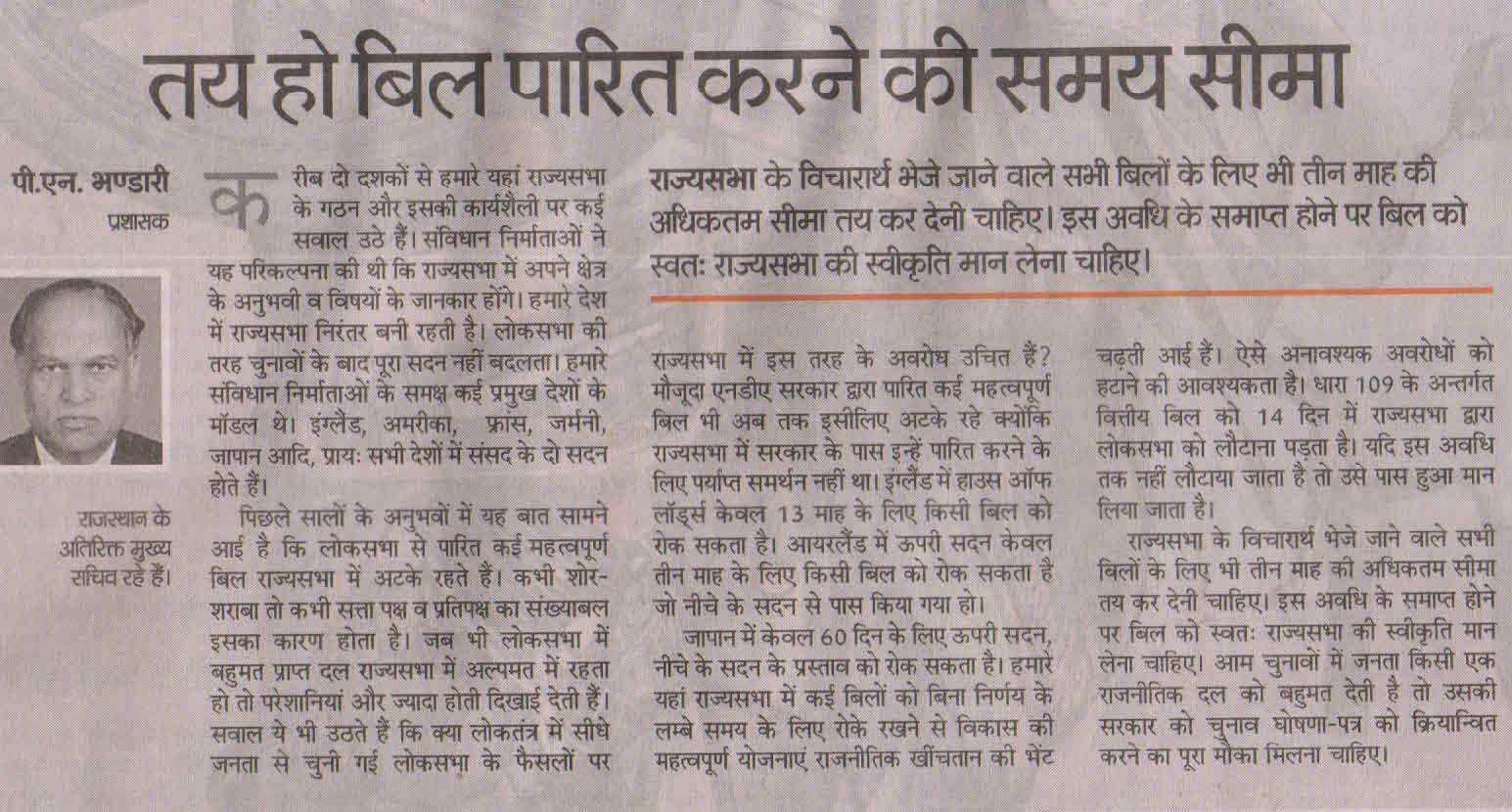


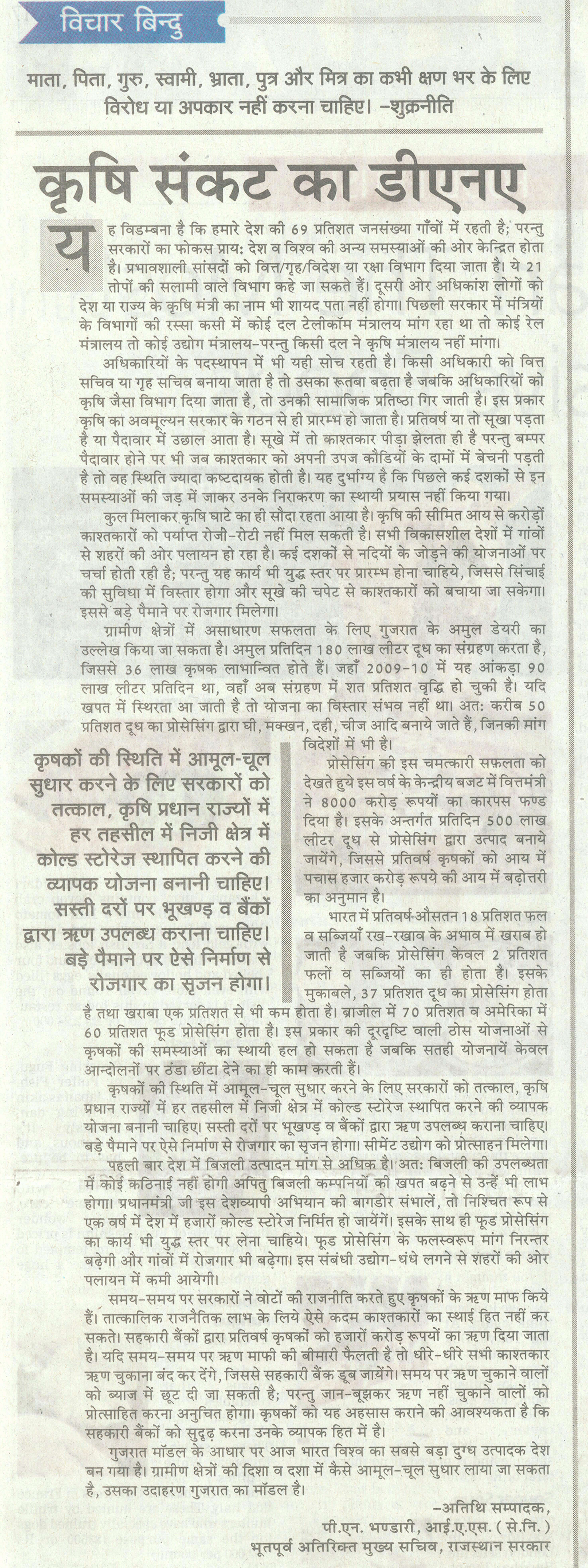
Rashtradoot Jaipur, 22nd June’2017
DNA OF AGRICULTURE CRISIS
– P.N. BHANDARI,
IAS (Retd.)
Former Additional Chief Secretary
Rajasthan
Notwithstanding the rhetoric of the governments regarding high priority for agriculture and the rural development, in reality the situation is just the reverse from the very inception of governments, whether in the Center or the States. The most influential/ talented MPs are picked up for Finance/HomeorDefence Ministry etc. Portfolios like Agriculture/ Rural Development may be given to left outs. At the end of the day, one may not be able to recall even the name of Agriculture Minister of India or of one’sown State. In the posting of bureaucrats again, the same caste system is visible. With a plethora of national and international issues, the focus,if any, on agriculture and rural development recedes to the background.
During elections, every party makes tall promises and tries to win elections through short term gimmicksbut it is lamentable that even after so many decades, too little has been done too late.
Agriculture revolves between two cycles of drought and bumper crop. Particularly after a bumper crop, when the prices crash, the agony of the farmers is acute. Long term strategy of governments could savesuch a pathetic situation.Agriculture even by the most liberal yardstick, is not a profitable venture. Agriculture cannot sustain 69% rural population of our country. It is just not viable.
The daily milk collection of Amul is 180 lac liters and around 36 lacs farmers are benefited by it. In 2009-10 the daily milk collection was barely 90 lacs liters but in such a short period, the milk collection has recorded a 100% jump. India has become the largest milk producer in the world. Almost 50% of the milk is processed for production of ghee, butter, curd, cheese etc. These processed products have international markets.
Impressed by the Gujarat model, in the recent budget, the Finance Minister, Arun Jaitley has very thoughtfully created a corpus of Rs.8000 crores, with NABARD for setting up of milk processing units. The proposal is to process 500 lac liter milk every day. With the corpus of barely Rs.8000 crores, the farmers are likely to have an additional income of around Rs.50000 crores every year.The return is more than six times, not once but year after year. Such vision is needed for long term strategy in agriculture sector.
Due to lack of proper storage and thrust on food processing, every year almost 18% of the fruits and vegetables perish in India while the processing is only for 2% of fruits and vegetables. Compared to this in milk, the component of processing is 37% and losses are less than 1% (to be precise 0.2%). What a remarkable metamorphosis can take place if the perishable component could be significantly reduced and the processing component could be given an exponential jump. In Brazil, the processing of fruits and vegetables is nearly 70% while in the USA it is around 60%.
A single step which can effectively prevent the recurring crashing of prices due to bumper crops is the construction of large number of cold storage units in private sector. In predominantly agricultural states, let every Tehsil have at least one cold storage.
This would generate lot of employment and boost cement production. Thanks to the dynamicleadership of Piyush Goyal, Minister for Energy and Coal, for the first time, electricity is surplus even during the peak load hours. Hence the cold storage units will get adequate electricity supply.
If the Prime Minister takes up the monitoring of such aprogramme, I am sure in barely one year, we could have thousands of cold storage units in the country. Fast implementation of a large number of schemes is the hallmark of the present government.
Against the above background, the loan waiver schemes would prove suicidal for our economy as well as farmers. In the long run it would harm rather than help the farmers. It will give the wrong message. Even those farmers who have been foolish enough to repay the loans would be encouraged to commit default in repayments. That would be a big blow, particularly to the large number of Cooperative Banks. If loans are not repaid, future loaning by banks would get choked. That would cause greater hardships to the farmers. This is not a onetime solution. This demand would become an annual feature.
If huge amounts are squandered on loan waivers, all developmental activities would come to a grinding halt. The rural areas require better roads, better health and educational facilities. These activities would immensely suffer as a result of loan waivers.
Of course the farmer’s agitation has ushered in “Achhe Din” for the opposition. It is not easy for the opposition to resist the temptation to escalate the agitation. In fact this is a golden opportunity for them but long term national interest should not be sacrificed for such short term gains. In the developed countries, on basic national issues, there is a broad national consensus.
We have debated interlinking of rivers for several decades. A time has come for translating the scheme on the ground. It would lead to a big jump in irrigation facility to the farmers, apart from hydel generation,the employment generation would jump exponentially.
Instead of frittering away our time and energy on violent agitations and non-issues relating to language or food habits or even history, we should all join in the nation building activities. In 1947 we were far ahead of China on a variety of fronts but today we are way behind China in most parameters. One is reminded of the clarion call of the late President Kennedy when he said “Ask not what the nation can do for you, ask what you can do for the nation”.
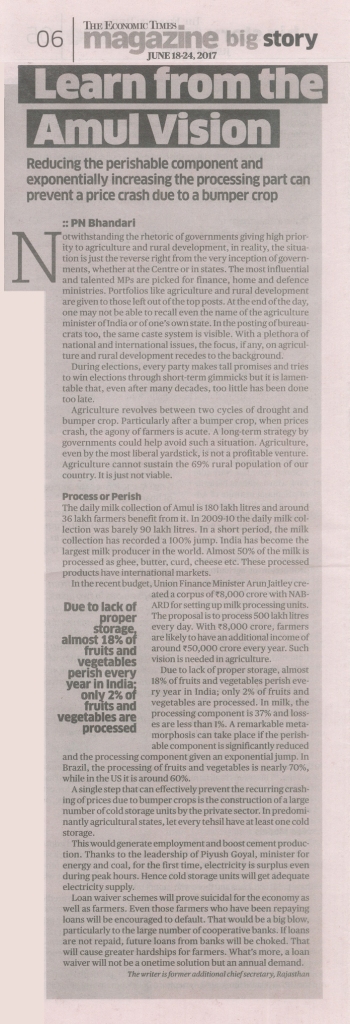
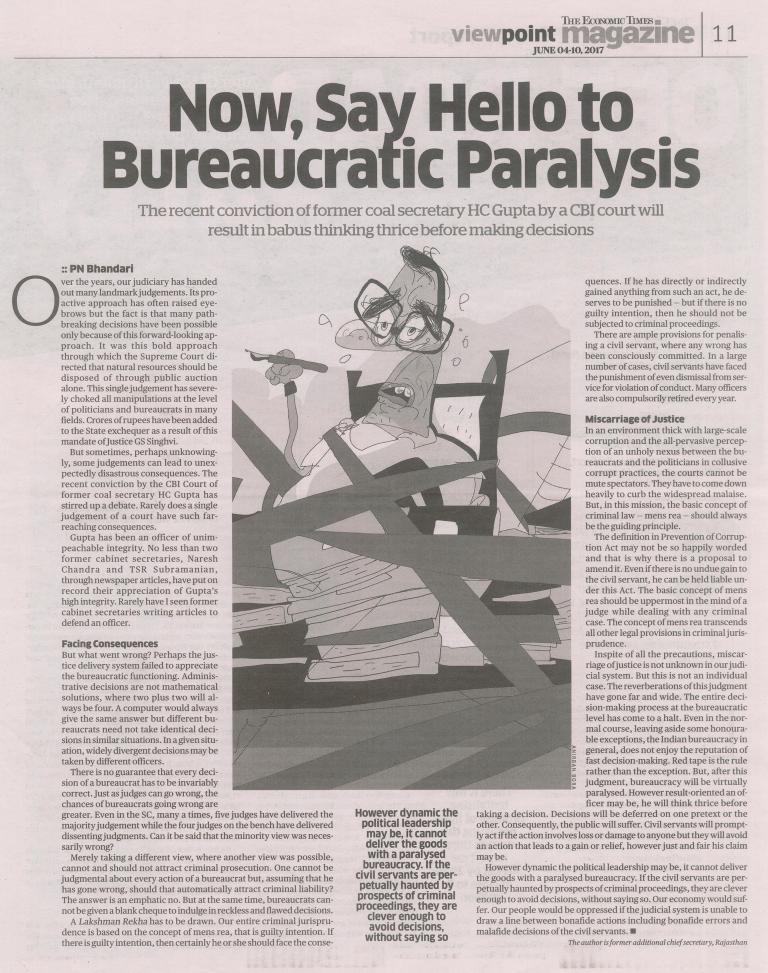
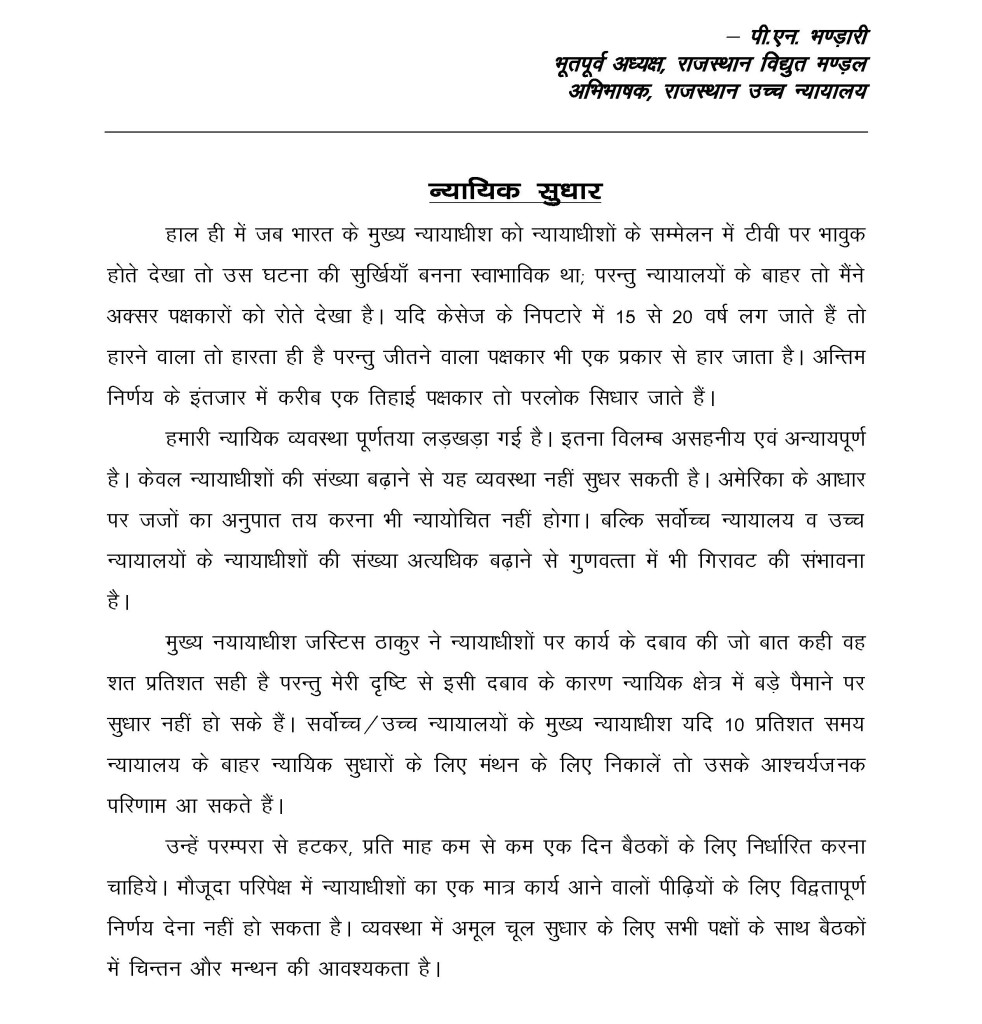
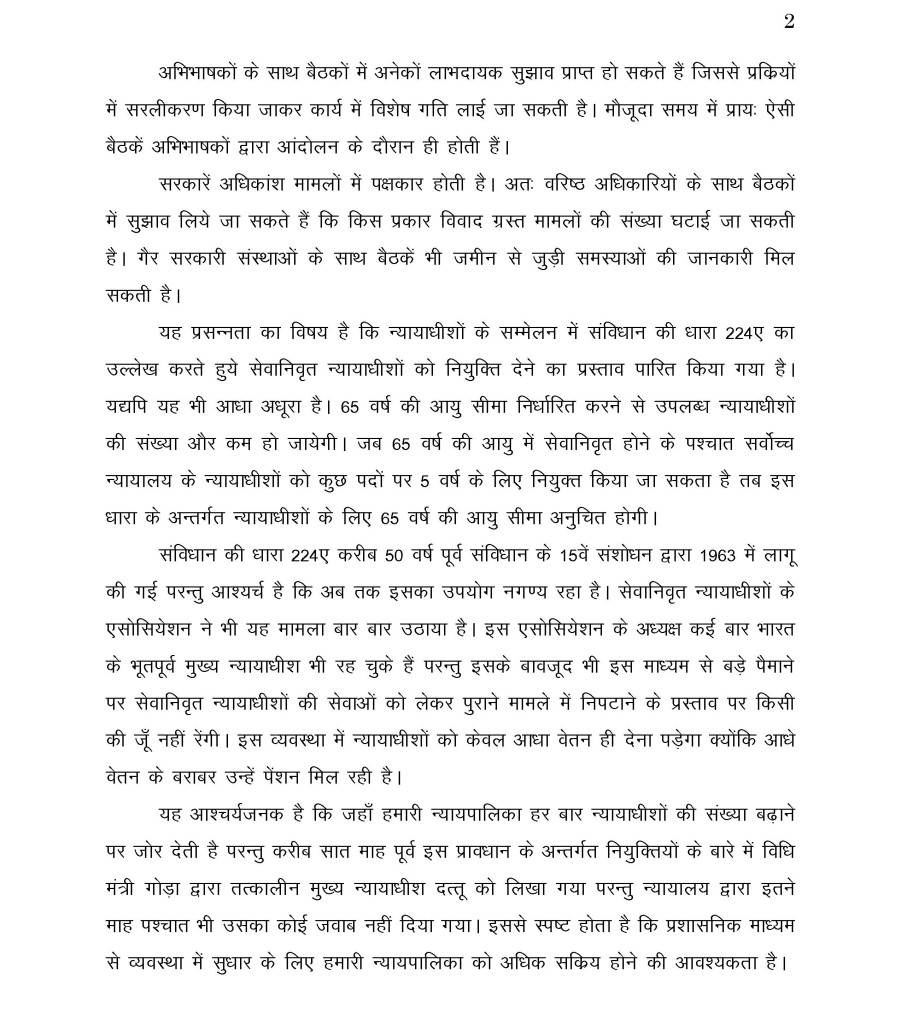
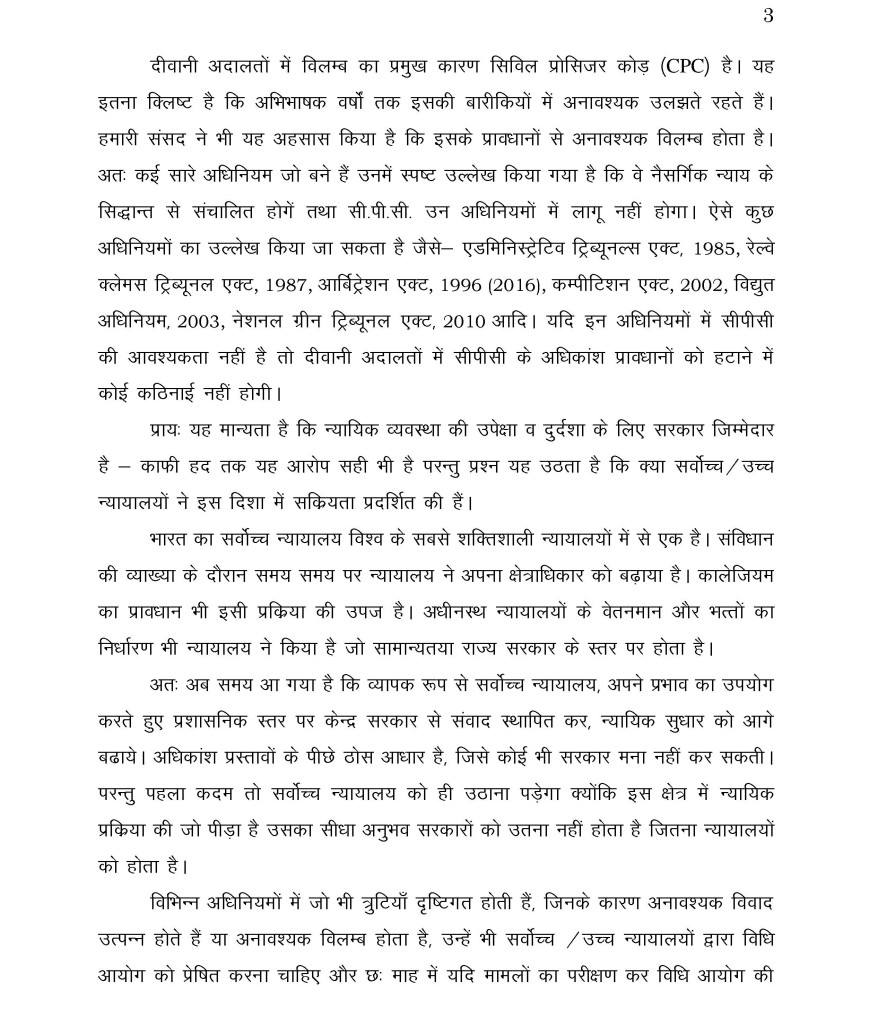
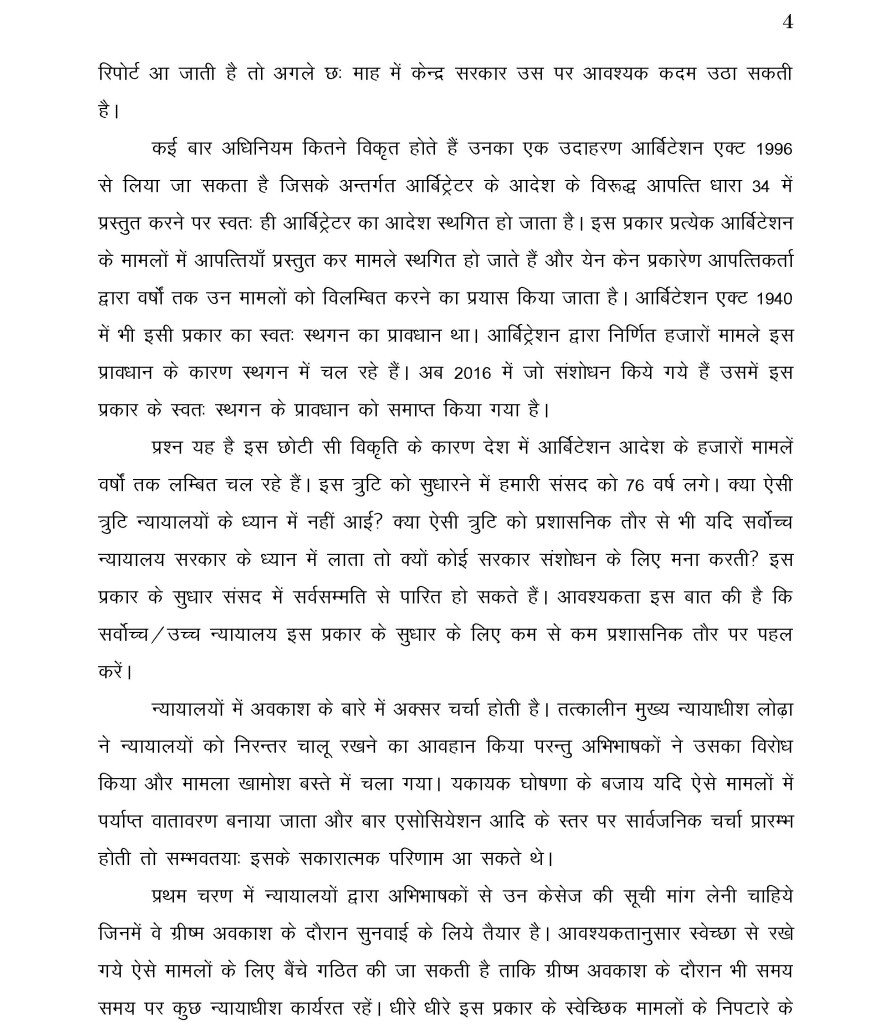
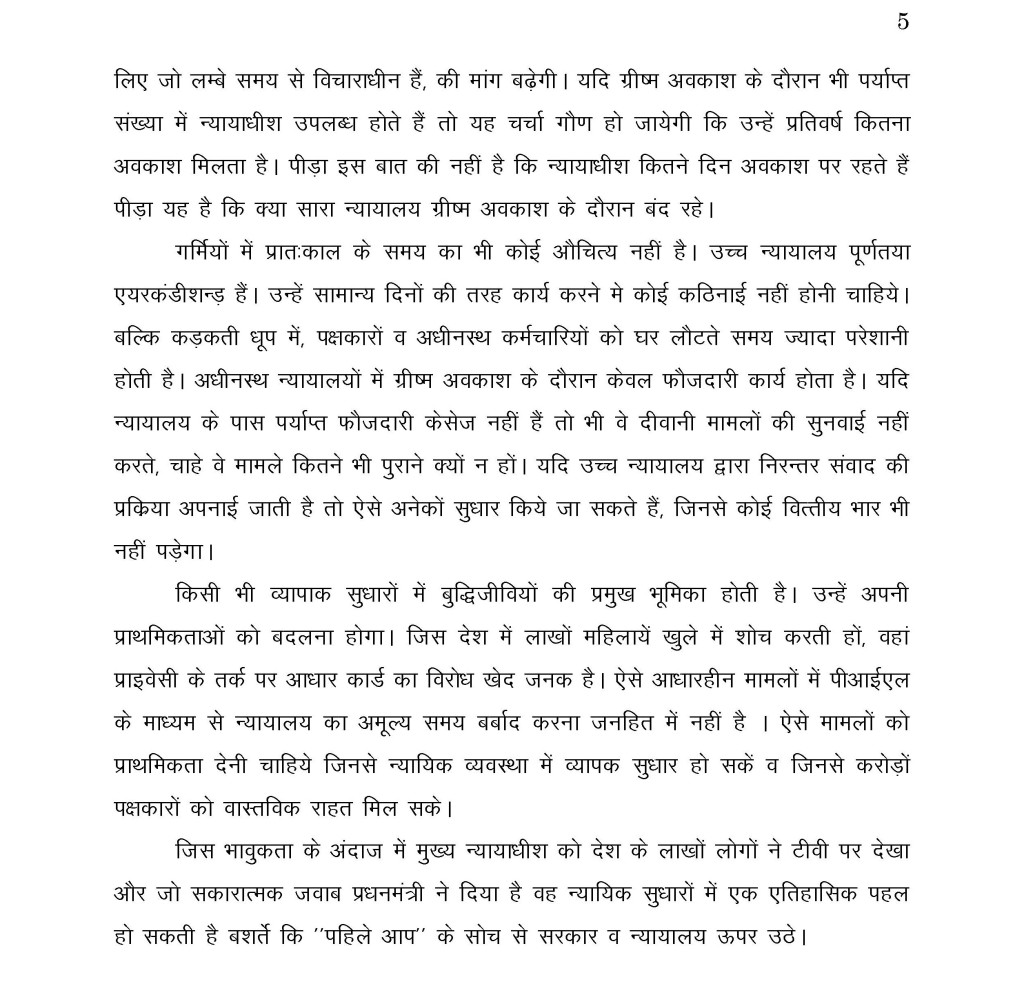
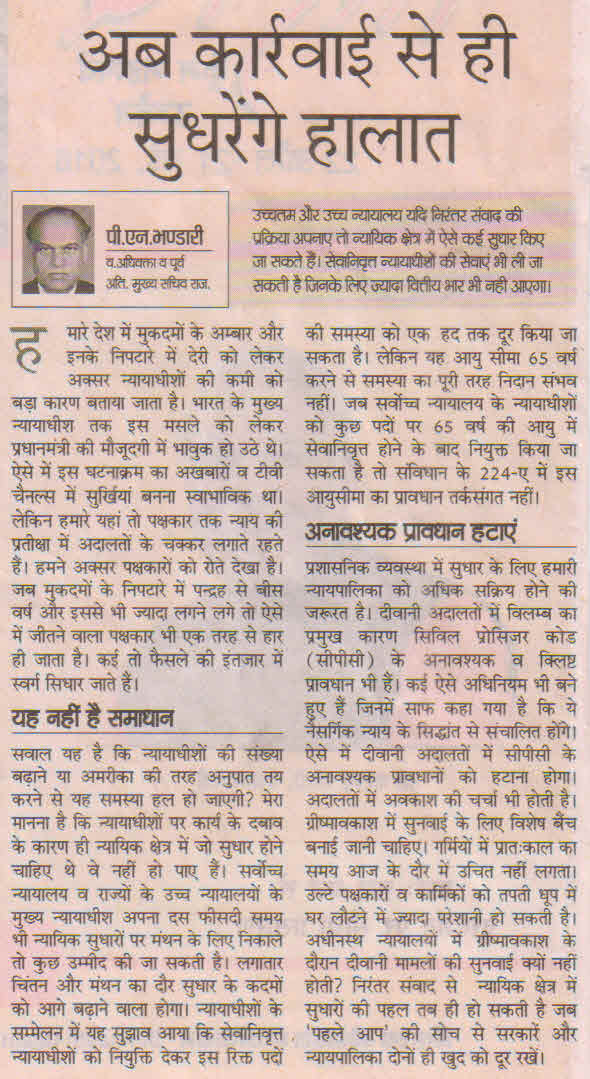
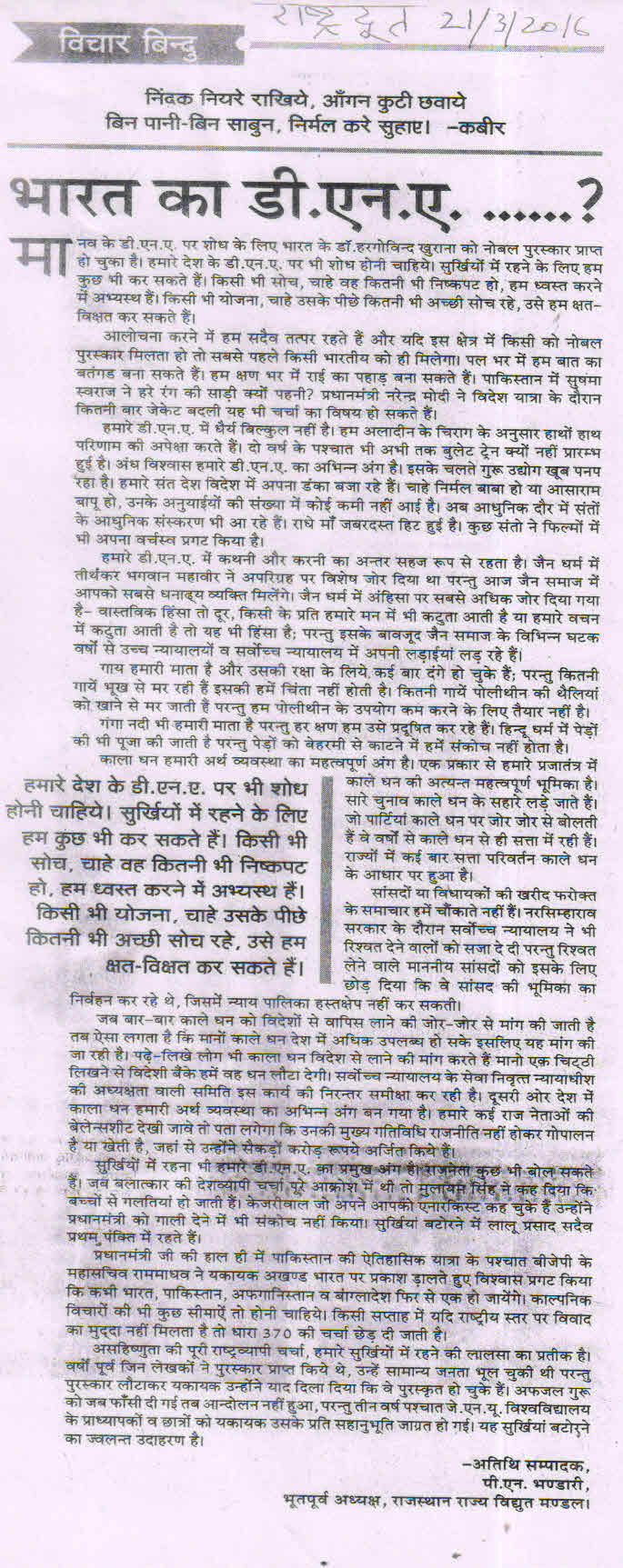
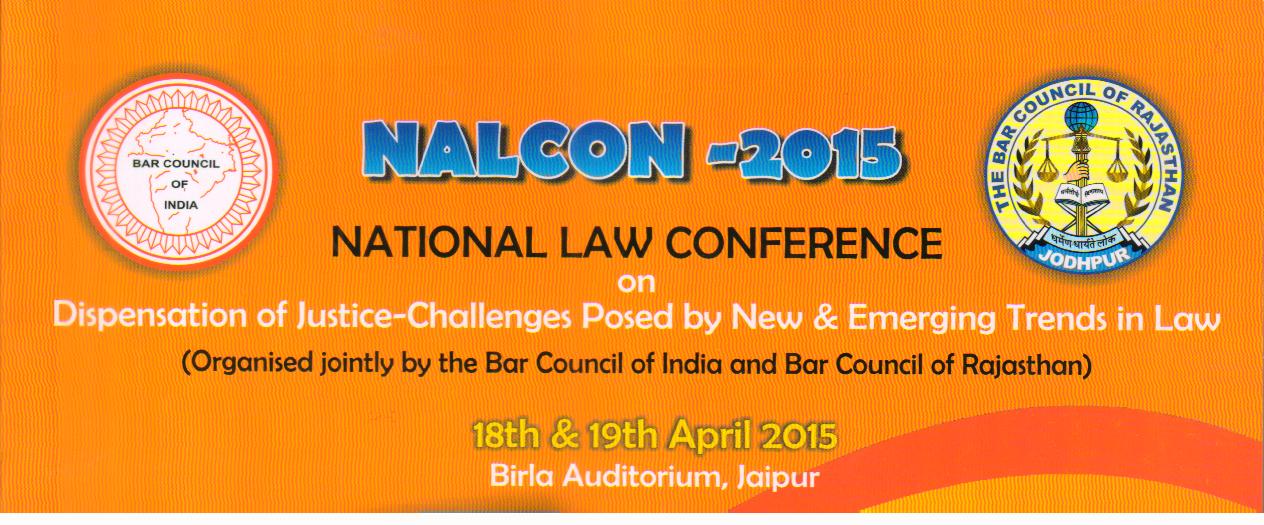
A ROAD MAP FOR TRANSFORMING THE JUSTICE DELIVERY SYSTEM
By P.N. Bhandari
Advocate, Rajasthan High Court
The major institutions in the country are increasingly falling in public esteem. Time and again, political parties hit the headlines for the wrong reasons. Of course in AAP, they are literally hitting each other. The ease with which the political parties stage an about turn on major policy issues astonishes no one. Any political party staunchly supporting a bill, while in the Government, would not mind vehemently opposing that very bill while in the opposition. Our law makers devote major time on issues other than law making. A study indicates that the largest number of bills have been passed, while shouting by the Hon’ble Members was at the maximum pitch.
Against the above back drop, the judiciary still enjoys abiding public faith. But we should not be unduly complacent. The proverbial delays in the Courts is a matter of deep public concern and growing disenchantment. No serious efforts beyond rhetorics have been made to tackle the staggering backlog of cases. The stock defence is that till the number of judges is increased, no visible improvement is possible. The cruel joke is that substantial number of vacancies continue even within the sanctioned strength. When path breaking judgments are delivered which have wide social impact, why can’t the stakeholders – the judiciary and the executive sit together and devise measures to ensure that at least the vacancies in the higher judiciary are filled up as soon as they fall vacant. After all even on the day a judge takes oath, his date of retirement is known.
Our judiciary has occasionally travelled in the realm of policy making, which at one time was considered to be the exclusive domain of the Government. This stretching of jurisdiction has also been generally welcomed because of its long term benefits.
Why can’t the judiciary introspect and take equally progressive measures for improving the justice delivery system. The judges are so much pre-occupied with the heavy cause list every day that they have hardly any time to pause or ponder about transforming the judicial system.
The Chief Justices should earmark one day every month for brain storming sessions with the members of the Bar and the other stakeholders. Such interaction can be very productive and they would receive immense feedback about the grass root level problems. Someone remarked that such interaction takes place only when the advocates launch any agitation.
The Government is the biggest litigant. In some of these interactive sessions, senior Government officials could also be invited to consider what positive steps can be taken for drastically reducing the thoughtless litigations. Through such interaction, concrete and far reaching results are bound to emerge. Presently the officers are generally summoned in the Court only for being reprimanded.
We often hear of the Supreme Court monitored Committees to tackle specific issues. I wish the Hon’ble Apex Court takes suo motu cognizance of this staggering problem and directs the Government of India to indicate is concrete road map for disposal of lacs of cases which are pending for more than five years. In the normal course the disposal of such cases would be impossible even if the strength of the judges is increased by 100%.
Most of the judges at the time of retirement are in perfect health. It is high time this valuable asset of retired judges is tapped and they are engaged, at least for a few years, for disposal of the old cases beyond five years. By engaging them on pay minus pension, the Government would get full time judges at half the emoluments.
Another thought which comes to my mind is that the Courts must dispel the general public perception that the system dispenses only paper justice. In the maze of hyper technicalities, lamentably justice recedes in the background. The orientation of the judges needs a change – lock, stock and barrel. The upper most consideration should be real justice. Fortunately law is not mathematics where two plus two would always make four. The judicial system provides enough elbow room while forming an opinion about a case.
Long back, I read an article by Justice P.N. Bhagwati, former Chief Just
ice of India. He indicated the names of the Judges of the Apex Court, where a murder accused will not be sentenced to death. He also indicated another list of Judges, where the accused was likely to face death sentence. This observation of Justice Bhagwati captures the wide flexibility enjoyed by the Judges while deciding the cases.
In a scenario of judge made law, through the mechanism of interpretation, the judges have enough flexibility. Therefore they should ensure that justice should not suffer due to hyper technicalities. If the judge is determined in imparting real justice, he would never be helpless, notwithstanding the cobwebs of law and procedure.
The endless delays in the functioning of the Civil Courts can be attributed to the cumbersome and dilatory operation of the Civil Procedure Code. In a large number of Acts enacted by the Parliament, it has been provided that the concerned authority will be guided by the principles of natural justice and would not be bound by the CPC. Example can be given of Administrative Tribunal’s Act, 1985, Railway Claims Tribunal Act, 1987, Arbitration Act, 1996, Competition Act, 2002, Electricity Act, 2003, National Green Tribunal Act, 2010 etc. The disposal of cases in Civil Courts would record a quantum jump if the CPC is scrapped and only a few selected provisions are retained through a new Act. If the problem is extraordinary, it cannot be solved by ordinary measures. When you have to cross a ditch, you have to take a big jump instead of moving step by step.
A high powered Commission should be appointed under the Chairmanship of Law Minister of India. Its members could be picked up from retired judges, jurists, retired and serving civil servants, social activists etc. It should organize interactive sessions with various stakeholders from time to time. Its mandate should be to suggest appropriate legal/administrative measures to make the judicial system move fast and with greater efficiency. Typically such Commissions/Committees come out with their elaborate reports after a year or two. We had enough of such academic exercises in the past but this Commission should function differently. Instead of merely making recommendations, it should simultaneously also monitor the actual implementation of its recommendations. Instead of releasing its full report, at the end of its term, it should periodically come out with its recommendations on each issue separately. This will ensure that the deliberations in the Commission and their implementation could be virtually done simultaneously.
